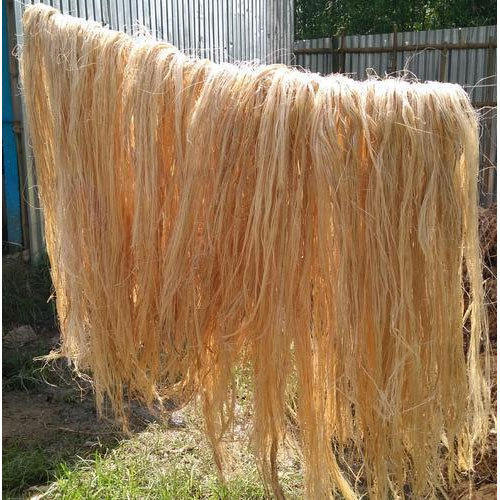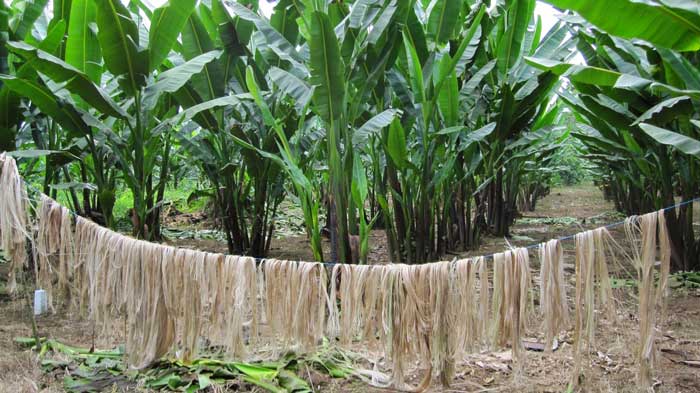No products in the cart.
News
Banana Fibre: A sustainable bioresource for eco-friendly applications
The use of banana stems as a source of fibre declined after other convenient fibres such as cotton and silk became popular. But in recent years the commercial value of banana fibre has increased and it is used all over the world for multiple purposes from making tea bags and sanitary napkins to Japanese yen notes and car tyres.
Banana fibre, also known as musa fibre, it is one of the strongest natural fibres. This biodegradable natural fibre from the bark of the banana plant is so durable that if we make currency notes from it, the notes can be used for more than a hundred years. It can be used to make silk grade saris and just as it can be used in car tyres.
Banana stem, hitherto considered a complete waste, is now is now being made into banana-fibre cloth which comes in differing weights and thicknesses based on what part of the banana stem the fibre was taken from. The innermost sheaths are where the softest fibres are obtained, and the thicker and sturdier fibres come from the outer sheaths.
Made up of thick-walled cell tissue and bonded by natural gums, banana fibre is similar to natural bamboo fibre but its fineness and spin ability are better bamboo and ramie fibres. It is mainly composed of cellulose, hemicelluloses and lignin.
When, Where, and How?
According to archaeologists, the banana was first domesticated in the Kuk valley of New Guinea around 8,000 BCE. Though this is the first known location of banana domestication, other spontaneous domestication projects may have occurred throughout South East Asia and the South Pacific.
Historically, banana stems had been used as a source of fibre with the earliest evidence dating to the 13th century. But its popularity faded after other convenient fibres such as cotton and silk were made popular. For centuries, banana fibre textiles were made in Japan and Nepal.
In Japan, banana fibres were a prized substitute for silk and were traditionally woven into ceremonial garments for the wealthy. In both Nepal and Japan, the outermost sheaths of the banana plant were used for making cloth that was not intended for articles of clothing. Coarser banana cloth was used for place mats, floor mats and sun shades.
Initially, people in Japan and Nepal realised that except for the fruit, the complete banana tree is cut and thrown as a waste. After exploring the tree, they figured out that the stalk can be used to make strong ropes. Eventually, they discovered other uses of banana fibre.
Characterstics of banana fibre:
- Natural sorbent: Fabric from this fibre lets you breathe well and will keep you cool on hot days.
- Soft, supple and shimmer: Banana fabric is soft and supple, though not quite as soft as cotton or rayon. Nearly all plant stem-based fibres are a little more stiff and coarse than cotton or rayon. Its natural shimmer makes it look a lot like silk.
- Comfort: Banana fibre clothing is comfortable and not likely to trigger allergies.
- Biodegradable.
- Resistance: It is grease-proof, water-, fire- and heat-resistant.
- Durability: Even if the banana fabric is made from the tough outer sheath, it is not as strong and durable as any fabric like hemp, bamboo, or other natural fibre.
- Insulation: It is not particularly insulating.
- Spin ability and tensile strength: It is better than other organic fibres in terms of spin ability and tensile strength
- .

| Properties | Banana fibre | Jute | Paper | Hemp | Sisal |
| Highest Tensile Strength | Yes | ||||
| Extensibility | Yes | ||||
| Water resistance | Yes | ||||
| Softness | Yes | Yes | Yes | ||
| Fire resistance | Yes | Yes | Yes | ||
| Grease proof | Yes |
What makes banana fibres special?
- Banana fibre is a good alternative to all the synthetic and natural fibres.
- Banana fibre is eco-friendly, chemical-free, non-toxic and odour-free.
- The natural coolant and medicinal property of banana fibres helps in the health of its user and is 100 per cent safe as no harmful chemicals and colours are used.
Fibre properties
| Tenacity | 29.98 g/denier |
| Fitness | 17.15 denier |
| Moisture regain | 13 per cent |
| Elongation | 6.54 |
| Alco-ben extractives | 1.70 per cent |
| Total cellulose | 81.8 per cent |
| Alpha cellulose | 61.5 per cent |
| Residual Gum | 41.9 per cent |
| Lignin | 15 per cent |
Banana fibre is also blended with many different fibres to make ring spun yarns and open end spun yarns. The following table shows their count:
| Banana fibre ring spun yarn | |
| Description | Count (Ne) |
| 100 per cent banana fibre yarn | 8-40 |
| 70 per cent banana fibre 30 per cent combed cotton | 16-40 |
| 50 per cent banana fibre 50 per cent combed cotton | 16-40 |
| 30 per cent banana fibre 70 per cent combed cotton | 16-40 |
| 70 per cent banana fibre 30 per cent modal | 16-40 |
| 30 per cent banana fibre 30 per cent tencel | 16-40 |
| 50 per cent banana fibre 50 per cent soybean fibre | 16-40 |
| Banana fibre open-end spinning yarn | |
| Description | Count (Ne) |
| 100 per cent banana fibre yarn | 8-21 |
| 70 per cent banana fibre 30 per cent combed cotton | 16-30 |
| 50 per cent banana fibre 50 per cent combed cotton | 16-30 |
| 30 per cent banana fibre 70 per cent combed cotton | 16-30 |
| 70 per cent banana fibre 30 per cent modal | 16-30 |
| 30 per cent banana fibre 30 per cent tencel | 16-30 |
| 50 per cent banana fibre 50 per cent | 16-30 |
Today, banana fibre is used all over world for multiple purposes. Commercial value of the fibre has increased over the years. Transforming the waste into a usable fabric and other products is a great achievement.


